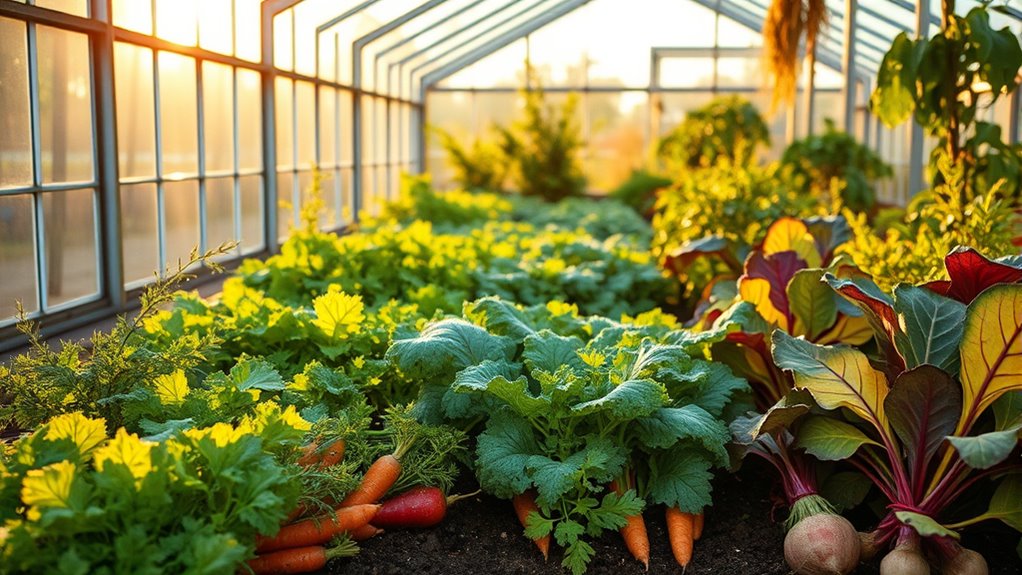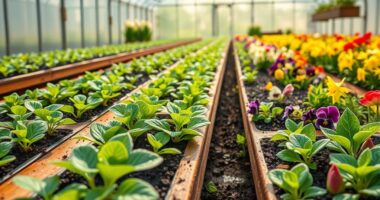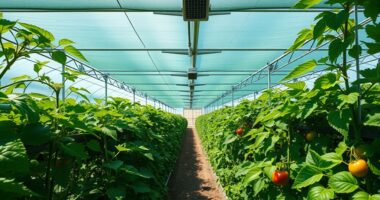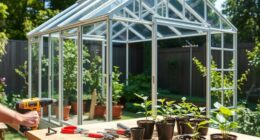In your fall greenhouse, focus on growing leafy greens like lettuce, spinach, and kale, which thrive in cooler temperatures. Herbs such as cilantro and parsley, along with root vegetables like carrots and radishes, also do well. Companion planting, like marigolds and garlic, can help repel pests naturally. Maintaining proper airflow and moisture keeps plants healthy. Want to discover more tips on maximizing your autumn harvest? Keep exploring to learn how to make the most of your greenhouse.
Key Takeaways
- Grow leafy greens like lettuce, spinach, and kale for quick harvests and cold tolerance.
- Plant root vegetables such as carrots and beets that store well for winter use.
- Incorporate herbs like cilantro, parsley, and chives to extend flavor options and pest resistance.
- Use companion planting with marigolds, garlic, and herbs to naturally deter pests and promote healthy growth.
- Maintain optimal greenhouse conditions with proper light, moisture, and airflow for consistent yields.
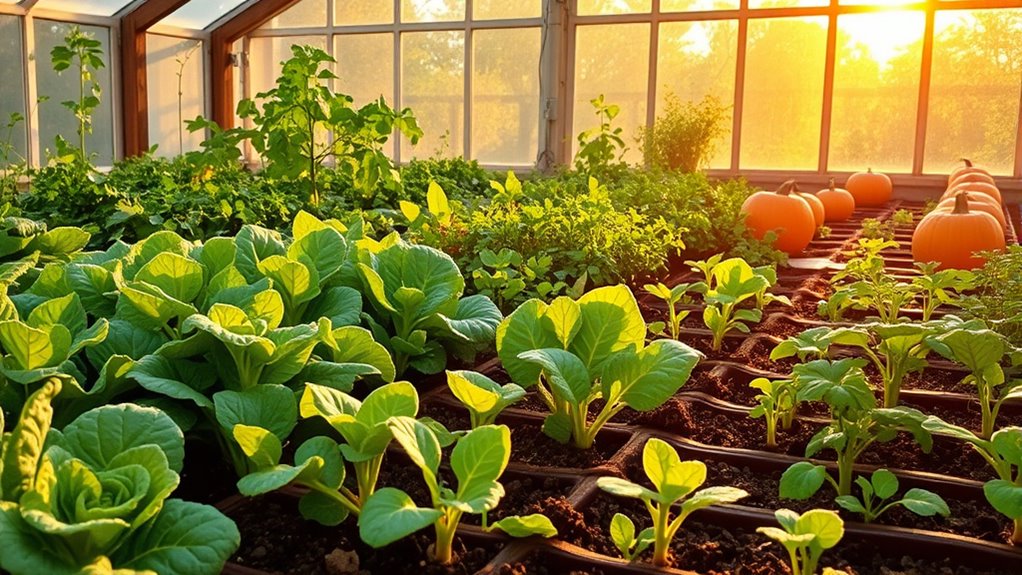
As temperatures begin to drop outside, fall greenhouse gardening offers a perfect opportunity to extend your growing season. Inside your greenhouse, you can cultivate a variety of crops that thrive in cooler weather, giving you fresh produce well into late autumn. One of the most effective strategies to ensure a healthy, productive garden is companion planting. By pairing certain plants together, you can naturally enhance growth, improve flavor, and create a balanced ecosystem that minimizes pests. For instance, planting herbs like basil or dill alongside vegetables can repel common pests, reducing the need for chemical interventions. Similarly, marigolds can be interplanted with leafy greens to deter aphids and nematodes, making pest management more straightforward and eco-friendly.
Fall greenhouse gardening also benefits from thoughtful crop selection. Crops like lettuce, spinach, kale, and radishes flourish in cooler temperatures and can often be harvested multiple times throughout the season. These leafy greens grow quickly, allowing you to maximize your space and enjoy fresh salads even as outdoor conditions become less favorable. Root vegetables such as carrots and beets also do well, providing hearty options that store well for winter. Additionally, herbs like cilantro, parsley, and chives can be grown indoors during the colder months, offering fresh flavor to your dishes and further supporting your pest management efforts. Keeping these crops healthy and thriving often involves maintaining proper airflow, moisture levels, and light, all of which are easier to control inside a greenhouse.
Another advantage of fall greenhouse gardening is that it allows you to extend your season with minimal effort. As the outdoor garden winds down, your greenhouse can act as a protected environment where pests are less prevalent, and plants are shielded from harsh weather. This means you can keep pests at bay more easily without resorting to pesticides, especially when you integrate companion planting strategies. For example, planting garlic or onions near susceptible crops can act as natural pest deterrents, reducing infestations and maintaining the health of your plants. Regular monitoring, combined with strategic plant pairings, helps you spot issues early and address pests before they become a significant problem.
Frequently Asked Questions
What Are the Best Pest Control Methods for Autumn Greenhouse Crops?
To control pests in your autumn greenhouse crops, start by practicing companion planting to naturally repel insects. Use organic pesticides like neem oil or insecticidal soap when necessary, applying them early in the morning or late in the evening to avoid harming beneficial insects. Regularly inspect your plants for signs of pests, and remove affected leaves promptly. Combining these methods helps keep your crops healthy and pest-free organically.
How Can I Extend the Growing Season in My Greenhouse?
They say, “Make hay while the sun shines,” so you can extend your season by using season extension techniques like adding insulation, heating, or grow lights. Incorporate crop selection strategies by choosing hardy or fast-maturing plants suited for cooler temperatures. You can also optimize ventilation and use row covers to protect crops, giving you a longer, productive growing season in your greenhouse.
What Are the Optimal Temperature Ranges for Fall Greenhouse Crops?
You should aim to keep your greenhouse temperature between 55°F and 75°F for ideal crop growth. Proper temperature regulation is key, especially during fall, to prevent cold stress and promote healthy development. Choose fall-friendly crops like leafy greens and root vegetables that thrive within this range. By maintaining consistent warmth and monitoring temperatures closely, you’ll guarantee your crops grow strong and productive throughout the autumn season.
How Do I Manage Humidity Levels During Autumn Greenhouse Gardening?
Imagine a humid mist swirling gently around your greenhouse, creating the perfect environment. You manage humidity control by monitoring moisture levels with a hygrometer and adjusting vents or dehumidifiers accordingly. Use watering techniques that avoid over-saturation, like watering early in the day and ensuring proper drainage. This keeps humidity steady, preventing mold and encouraging healthy growth. Stay attentive, and your autumn crops will thrive amidst the balanced, lush atmosphere you create.
Can I Grow Tropical Plants Successfully in a Fall Greenhouse?
Yes, you can grow tropical plants successfully in a fall greenhouse by providing proper tropical plant care. Focus on maintaining warm temperatures, high humidity, and adequate lighting. Choose greenhouse tropical varieties suited for cooler months, and guarantee good air circulation to prevent diseases. Regular watering and fertilization help your tropical plants thrive. With attentive care, your tropical plants will flourish and add vibrant color to your autumn greenhouse.
Conclusion
By choosing the right crops for your fall greenhouse, you can extend your gardening season and enjoy fresh produce even as temperatures drop. For example, Sarah planted spinach and lettuce in her greenhouse last autumn, and she was able to harvest greens well into December. With a little planning, you too can enjoy a thriving fall garden. So, embrace the possibilities of autumn gardening and make the most of your greenhouse’s potential all season long.
